FiiO K11
FiiO K11 Review
The K11 is FiiO’s new entry level headphone amplifier. But is both an incredible nice looking device and also incredible feature rich, this might be the only headphone amplifier you will ever need, to find out why read on:

Thanks to FiiO for providing me with the K11 for this review.
A note about FiiO Naming:
I think its worth clarifying FiiO’s new device naming conventions. With a device name like the K11 - you might expect this headphone amplifier to be the top of FiiO range, considering FiiO already offer a K9, K7, K5 and even a K3.
But a quick check on FiiO website clarifies that they have adopted a new naming convention for their devices.Therefore the 11 number actually means update 1 of a level 1. Therefore, we will no doubt see future headphone amps named K15, K17, K19’s as FiiO upgrade their range.
But the naming convention is not the only ’new’ aspect of this headphone amp. It is the first of this product line from FiiO to contain a screen with a new user interface and expose associated ‘platform’ with many features that are currently unique to the K11.
I would also expect future FiiO products K15, K17 etc to be based of this new platform and contain a similar display to access those features as the K11.
Before we get into the features and sound quality lets check the packaging:
What’s in the box
As you would expect from FiiO the packaging is excellent:
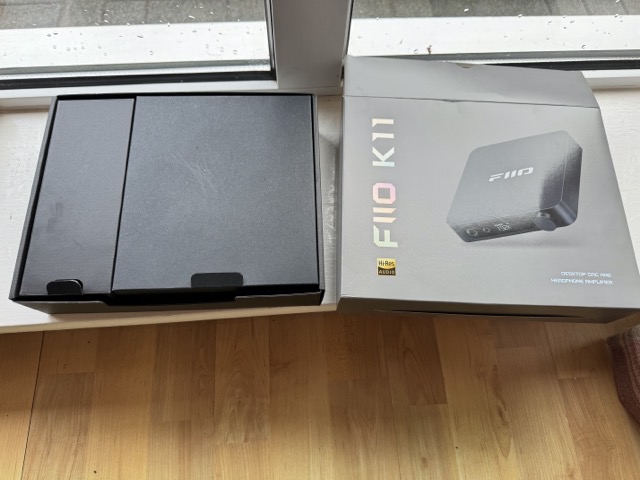
And nicely laid out within the box:
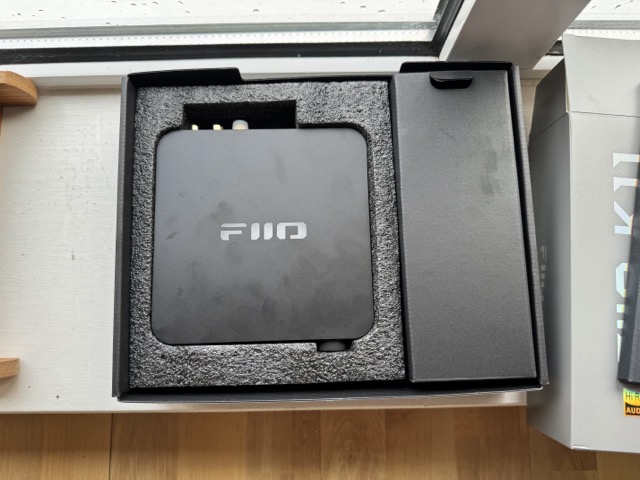
Once you take everything out of the box, as well as the power supply you get a USB cable and a 3.5mm adapter.
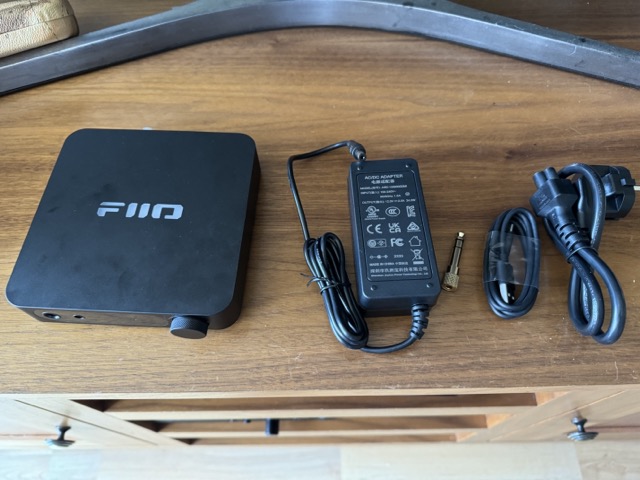
Looking at the K11 itself I thought it might be usefull to compare the size with the K7:
 On the front you get a nice volume control (that is volume control is central to accessing the features of the K11 - see later on for details) and both a balanced 4.4mm and a 3.5mm headphone jacks.
On the front you get a nice volume control (that is volume control is central to accessing the features of the K11 - see later on for details) and both a balanced 4.4mm and a 3.5mm headphone jacks.
As you can see it is slightly wider but less tall than the K7, the underside of the K11 has a nice non-slip mat to keep it in place.
Around the back you a modern USB-C connection (instead of the older USB connection on the K7), a optical and a coaxial inputs and a RCA output (LO in FiiO terminal) for connection to an external amplifier or powered speaker.
 Note: It lacks the RCA input that K7 provides but the interesting the coaxial can act as an output as well as input.
Note: It lacks the RCA input that K7 provides but the interesting the coaxial can act as an output as well as input.
Overall the K11 has a very clean and well laid out design.
Features
So the K11 has a tremendous amount of features and there is allot going on behind that volume button.
First the screen is small but easy visible and the ‘home’ page information is nicely laid out:
 The screen by default shows:
The screen by default shows:
- the gain level (high, medium or low)
- the format (PCM or DSD)
- the output (PO for headphone, LO for Line out / RCA output and Coaxial output if connected)
- bitrate of the input in this case I have set the maximum availalbe via the UAC-2 option and set on my Macbook Pro
- the Volume level
The volume button does feels a bit cheap when adjusting the volume especially compared to the K7, but the key thing is that the button is clickable in 2 ways:
- A short click access input switch - between the USB, Optical and Coaxial inputs - it returns to the default screen above after a timeout
- A long press and hold - this switches the display to show the options menu.
The Options Menu is the heart of configuration of this headphone amplifier ( this is the “new platform” for configuration of the K11 and I believe we will see similar in future FiiO desktop headphone amplifiers ). It has the following options:
- Gain (High, Medium, Low) - see below
- Output (LO - Line out or PO headphone output)
- Filt - this is the filter menu and there are 6 filters available (more about this in the subjective listening section):
- 1 Minimum phase fast roll-off filter
- 2 Fast roll-off, Phase-compensated filter
- 3 Minimum phase slow roll-off filter
- 4 Slow roll-off, Phase-compensated filter
- 5 Wideband flatness filter
- 6 Non over-sampling filter
- UAC (1 or 2) - this option allows configuration of the USB-C connection - 1 is compatible with older devices while 2 has much higher bandwidth and supports 384K 32bit audio
- RGB - there are 3 separate menus for configuring the RGB on the top of the box
- LCD - there are 2 separate menus for brightness and timeout of the LCD on the front of the box
- Reset - this restores all the settings to their default
- Update - this restarts the K11 into update mode - I had no updates
- Return - back to the ‘home’ screen
FiiO provided a useful graph of the difference in gain:
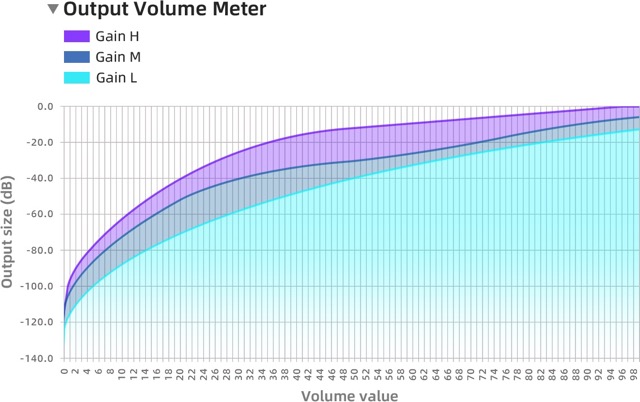
Desktop and mobile DAC

When connected to a PC or MAC you can utilise the UAC 2 mode above and this provides excellent hi-res audio support of up to 384K.

When connected in UAC 1 mode it only supports 96 Khz:
 Before we get into the sound quality and playing with some of these features, lets delve a little into the measurements:
Before we get into the sound quality and playing with some of these features, lets delve a little into the measurements:
I also tried the K11 with my new iPhone 15 (using its USB-C connection):
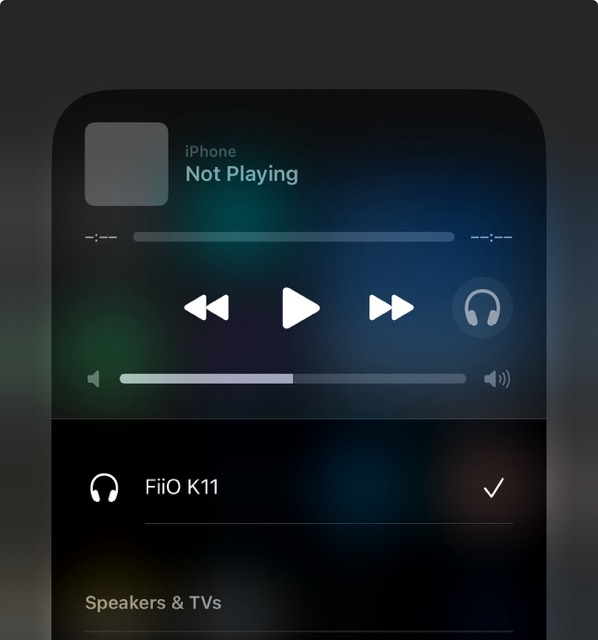 Though I was limited to 44khz output - this is an IOS restriction I believe.
Though I was limited to 44khz output - this is an IOS restriction I believe.
Measurements & Specifications and technical comparisons
This being the FiiO entry level headphone DAC we should not expect SOTA measurements. The 2 core components of the K11 are its DAC which is a single CS43198 DAC and its headphone amplifier which is a dual SGM8262-2 setup. FiiO has already used these components in its entry level portable headphone Amp the Q11 but with the K11 they are using dual 8262-2 for a much more powerful amplification as we will see in the specification below.
The CS43198 DAC itself is an excellent choice and used in many more expensive headphones amplifiers
and FiiO themselves has used this DAC in various configurations include dual CS43198 in the FiiO JadeAudio KA5.
I would not be surprised if we see a K13 or K15 with both dual CS43198 and dual SGM8262-2 in the next year.
By only having a single CS43198 the K11 does suffer from low THD+N / SINAD measurements especially when measuring
the balanced output as we can see in the figures below:
The 4.4mm balance SINAD score 97 is reasonable for an entry level device.

The 3.5mm SINAD score of 104.5 is pretty competitive with, for example, a similar score to the Schiit Magni 3+

Note: While the THD+N / SINAD ‘score’ is an excellent measure of engineering excellence, once you get a score in the 90+ range the difference are mostly of engineering interested, as any differences will be in-audible. Therefore, in an entry level device these measurements are perfectly acceptable.
Higher SINAD is really for those chasing excellence that they cannot hear.
The Line Out of the K11 has THD+N value of 0.00035% which is a SINAD of 108.57 dB which is an excellent score for an entry level DAC, though certainly not SOTA.
Headphone output Power
In my opinion, the power output of a headphone amplifier is much more important once a reasonable level of THD+N / SINAD has been reached and the K11 does not disappoint.
The following table shows an excellent amount of power from both the 3.5mm and the 4.4mm headphone jacks:
| Power (L + R) | Ohms | THD+N | |
|---|---|---|---|
| 3.5mm (Single Ended) | 720mW+720mW | 16Ω | < 1% |
| 520mW+520mW | 32Ω | < 1% | |
| 60mW+60mW | 300Ω | < 1% | |
| 4.4mm (Balanced) | 570mW+570mW | 16Ω | < 1% |
| 1400mW+1400mW | 32Ω | < 1% | |
| 250mW+250mW | 300Ω | < 1% |
This shows that the K11 can drive most demanding headphones easily and when I used the K11 with my more demanding planars it was not found wanting.
For those interested FiiO provides extensive specifications on their website
Technical Comparisons
I have been a long term fan and daily user of the FiiO K7 and I was fastinated to see how the K11 would stack up against it. I was also keen to see how the K11 would compare with the entry level headphone dac’s from SMSL and Topping.
Compared to the K7:
The K11 has many many more features than the K7, but the K7 does have more power and has much better measurements. It also a few simple features that I did miss when using the K11, specifically a simple switch on the front to switch inputs, but I missed the volume control on the K7 as it is much more premium than the one on the K11.
K7 power for comparison - effectively the K7 has double the power of the K11:
| Power (L + R) | Ohms | THD+N | |
|---|---|---|---|
| 6.3mm (Single Ended) | 1220mW+1220mW | 32Ω | < 1% |
| 140mW+140mW | 300Ω | < 1% | |
| 4.4mm (Balanced) | 2000mW+2000mW | 32Ω | < 1% |
| 560mW+560mW | 300Ω | < 1% |
Also, and its probably very subjective but I feel that the THX AAA 788+ Amplifier in the K7 sounded ‘cleaner’ than the dual SGM8262-2 in the K11.
But this is probably an unfair comparison considering the K7 is roughly double the price of the K11.
I cannot wait to see what FiiO will do with what I am guessing will eventually be called the K17.
I will be doing a long term review of the K7 very soon with more details.
Compared to the SMSL M300SE:
The SMSL support MQA files, supports up to 768khz 32bit DSD files and has better SINAD scores. But in the more important area, output power the SMSL is massively lacking compared to the K11:
| Power (L + R) | Ohms | THD+N | |
|---|---|---|---|
| 4.4mm (Balanced) | 148mw+148mW | 32Ω | < 1% |
| 15mW+15mW | 300Ω | < 1% |
In my opinion, those values are not competitive at all.
Compared to similar priced offerings from TOPPING
Topping doesn’t have a similar priced offering to the K11, their base models are either a basic DAC without headphone output like the D10 or a headphone amp / pre-amp like the L30. While some people will prefer having 2 separate devices it effectively double the price compared to the K11.
The TOPPING DX3pro+ DAC + Headphone Amp has some similar features to the K11 but it is also double the price and is more competitive with the FiiO K7.
Even then the topping does not have a balanced 4.4mm output so these figures are just for the 3.5mm:
| Power (L + R) | Ohms | THD+N | |
|---|---|---|---|
| 3.5mm (Single Ended) | 1800mW+1800mW | 32Ω | < 1% |
| 900mW+900mW | 64Ω | < 1% | |
| 250mW+250mW | 300Ω | < 1% |
Sound Impressions
FiiO’s DACs and amps are known for their ability to provide a clean neutral listening experience, and the K11 lives up to this reputation.
When using headphones like the Hifiman XS and Sennheiser HD-600 benefit from the K11’s ability to provide that power over the balanced output for the absolute best sounding output.
There is no sense of colouring the output, so you are getting crystal clear sound the way it should be, contributing to an overall balanced sound profile.

In my listening tests with my Hifiman Edition XS and HE-400SE I found the K11 had ample power to drive these planars both via the 3.5mm and via the 4.4mm.
While there is no colouring of the sound with this amplifier, FiiO does provide the K11 with 6 interesting filters to play with the top end of the frequency response, for example, filter option 4 is a slow roll off filter which lowers the upper treble region earlier and might be useful for headphones with extra ‘peaky’ treble. But I decided that for me a sharp roll off ( filter 1 or 2 ) gives the most natural sounding response.
Rating:
I gave this headphone amp a pragmatic rating of 4, it offers amazing value for money and lots of features but the measurements while excellent at this price point keep it from being the only headphone amp you would ever need.
Summary:
 The K11 is an amazing bargain and for those looking to get into the hobby it is a great feature rich first headphone amp.
It might even be the only headphone amplifier you will ever need, given the K11 power especially from its balanced headphone jack.
The K11 is an amazing bargain and for those looking to get into the hobby it is a great feature rich first headphone amp.
It might even be the only headphone amplifier you will ever need, given the K11 power especially from its balanced headphone jack.
But for me the real star of the K11 is the features it provides and how easily accessible these are via the lovely screen.
In my opinion, the K11 sets a new standard in terms of both performance and budget-friendliness, making it the pragmatic choice for those who want a great headphone experience without breaking the bank.